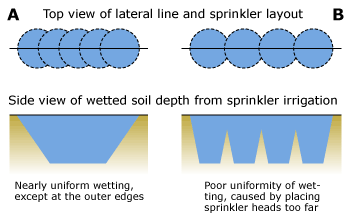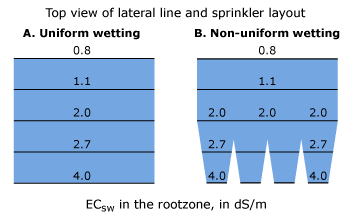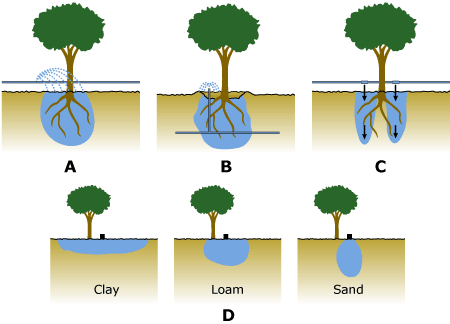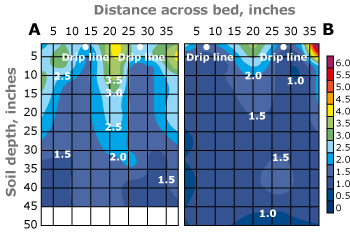- Home
- Learn about salinity
- Get to know your site
- Design a landscape
- Solve a problem
- Other information
Salinity Management Guide
Effect of irrigation application method on salinity of soil water

Figure 6. Two sprinkler layouts and the corresponding (idealized) wetting patterns
Sprinkling is the most common irrigation method for applying recycled water to turfgrass landscapes. When using sprinklers, remember that the outer margin of each circular zone wetted by a single sprinkler nozzle receives less water than the center portion. Figure 6 depicts the layout of a line of sprinklers on a field of turf. In part (a) of the illustration, the wetted zones corresponding to the various sprinklers overlap considerably and the soil is wetted uniformly. (This view is somewhat idealized, as 100% uniformity of irrigation is seldom achieved.) By contrast, part (b) of the illustration depicts a situation where the sprinkler heads are too far apart and overlap of the wetted zones is insufficient, resulting in nonuniform wetting of the soil. To help avoid this, when irrigating turfgrass, lay out lateral lines in a parallel fashion with sprinklers offset, to obtain good overlapping of the wetted zones.

Figure 7. Patterns of salt accumulation in the wetted zone for the two sprinkler layouts depicted in the previous figure; ECsw expressed in dS/m
Salt dissolved in irrigation water tends to move along with the water as the water flows through the soil. Figure 7 depicts the pattern of salt accumulation for the two cases cited above. Part (a) is for the situation where sprinklers are close enough to one another that the wetted zones overlap, resulting in uniform wetting of the root zone. As might be expected, the salts are distributed uniformly in the horizontal direction. In the vertical dimension, however, the shallower portions of the root zone contain less salt than the deeper portions, as a result of the leaching fraction, LF. Stated another way, a greater flushing of salts occurs at shallow depths than at the deeper soil depths. The numbers on the diagram, representing ECsw, reveal that salt tends to accumulate in the bottom soil depths. Part (b) of the figure is for a situation where sprinklers are too far apart, resulting in nonuniform wetting of the root zone. The result is a nonuniform distribution of salts, both in the vertical direction and the horizontal direction. For this latter (nonuniform) example, the vertical distribution of salts in the wetted zone is identical to that for the uniformly wetted case except that in regions with insufficient sprinkler overlaps, the LF is smaller and, hence, the ECsw is higher (e.g., 8 dS/m in the central zone).

Figure 8. Micro-spray (a), bubbler (b), and dual-drip (c) irrigation of trees and shrubs, and the wetting patterns of drip irrigation in clayey, loamy, and sandy soils (d). After FAO, 1997.
Trees, shrubs, vines, groundcovers, and bedding plants sometimes are irrigated by sprinkling. Just as often, though, they are watered by means of micro-spray, bubbler, or drip irrigation systems. Figure 8 illustrates the typical wetting pattern for each of these methods.
The distribution of salt in these localized wetting patterns may differ from that of sprinkler irrigation. For a micro-spray system that sprays a relatively large wetted zone around each plant, salt may accumulate within each zone in a pattern not unlike that of a lone sprinkler. In contrast, for an irrigation system employing drip emitters or bubblers, salt tends to accumulate mainly in the outer fringes of the wetted zone.

Figure 9. Pattern of salinity for soil wetted by a dual-drip irrigation system at relatively low (a) and high (b) leaching fraction. The vertical scale at right shows the value of ECe associated with each color. From Hanson and Bendixon (2004).
Figure 9 shows actual salinity patterns for a dual-drip-irrigated soil at low and high leaching fractions (Hanson and Bendixon, 2004). The salinity parameter used to create this figure is ECe — the EC of the extract of a saturated soil paste, expressed in dS/m. For a leaching factor of 0.2, ECsw is approximately 2.7 times greater than that of ECe. This conversion factor between ECe and ECsw varies with leaching factor; for example, for LF of 0.1, the factor is 4.2, and for LF of 0.3, the factor is 2.0. Note that ECe is relatively low beneath the drip emitters (depicted as white dots near the soil surface) because that is the wetted zone. Conversely, ECe is higher between the emitters and at the outer margins of the wetted zone.
| « Previous page | Next page » |